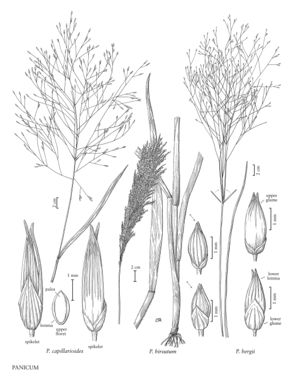Difference between revisions of "Panicum capillarioides"
imported>Volume Importer |
imported>Volume Importer |
||
| Line 39: | Line 39: | ||
|publication year= | |publication year= | ||
|special status= | |special status= | ||
| − | |source xml=https://bitbucket.org/aafc-mbb/fna-data-curation/src/ | + | |source xml=https://bitbucket.org/aafc-mbb/fna-data-curation/src/200273ad09963decb8fc72550212de541d86569d/coarse_grained_fna_xml/V25/V25_1245.xml |
|subfamily=Poaceae subfam. Panicoideae | |subfamily=Poaceae subfam. Panicoideae | ||
|tribe=Poaceae tribe Paniceae | |tribe=Poaceae tribe Paniceae | ||
Latest revision as of 18:56, 11 May 2021
Plants perennial; cespitose from a knotty crown, hirsute, hairs papillose-based or glabrous. Culms 30-75 cm tall, 1-2 mm thick, terete to slightly compressed, erect or ascending, stiff, often bent at the nodes, simple or sparingly branched; nodes densely pubescent. Sheaths shorter than or equaling the internodes, rounded, hirsute, green or tinged with purple, margins ciliate; ligules 0.5-1 mm; blades 12-30 cm long, 2-12 mm wide, stiffly erect or ascending, flat, pubescent, sometimes sparsely so, hairs papillose-based, bases truncate, apices attenuate. Panicles terminal, 15-30 cm long, 10-12(26) cm wide, usually shortly exserted, scarcely overtopping the blades; rachises hispid, some¬times glabrous basally; primary branches alternate or opposite, divergent, secondary branches divergent, most abundant on the distal 1/3 of the primary branches, with 1-3 spikelets; pedicels 2-20 mm, confined to the distal 1/3 of the branches; pulvini poorly developed, shortly pilose. Spikelets 5-6.5 mm long, 1-1.2 mm wide, glabrous, long-acuminate. Lower glumes 2-3 mm, about 1/2 as long as the spikelets, attached about 0.4 mm below the upper glumes, 5-7-veined, acute to obtuse; upper glumes and lower lemmas 5-6 mm, exceeding the upper florets by 3-4 mm, 9-13-veined; lower florets sterile; lower paleas 1.5-2 mm, acute; upper florets 1.6-2 mm long, 1-1.1 mm wide, smooth, chestnut brown when mature. 2n = 36.
Discussion
Panicum capillarioides grows in sandy grasslands, oak savannahs, and rangelands from southern Texas to northern Mexico.
Selected References
None.
